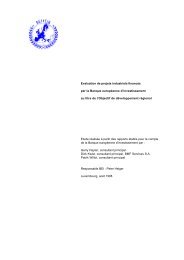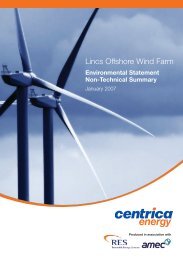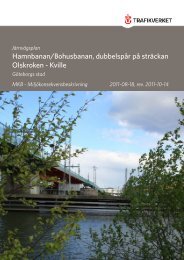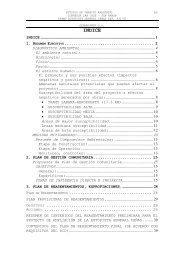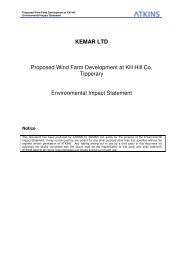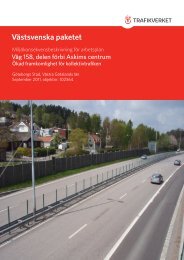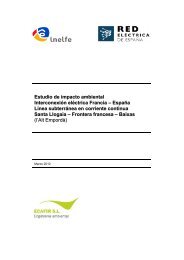Evaluation of Railway Projects in the European Union
Evaluation of Railway Projects in the European Union
Evaluation of Railway Projects in the European Union
You also want an ePaper? Increase the reach of your titles
YUMPU automatically turns print PDFs into web optimized ePapers that Google loves.
3. Relevance/Effectiveness <strong>of</strong> <strong>Projects</strong>3.1 Contribution <strong>of</strong> <strong>Projects</strong> to Objectives3.1.1 EU and national objectivesAll projects exam<strong>in</strong>ed <strong>in</strong> depth were eligible for f<strong>in</strong>anc<strong>in</strong>g under <strong>the</strong> current Article 267 (formerlyArticles 130/198e) <strong>of</strong> <strong>the</strong> EU Treaty. One project was situated <strong>in</strong> a less developed region <strong>of</strong> <strong>the</strong> EUand was thus eligible by virtue <strong>of</strong> Article 267(a), n<strong>in</strong>e projects complied with both paragraphs (a) and(c) (projects <strong>of</strong> Community <strong>in</strong>terest), and six projects were eligible on account <strong>of</strong> <strong>the</strong>ir Community<strong>in</strong>terest (Art. 267(c)). Of <strong>the</strong> 13 desk review projects, five complied with Art. 267(c) and <strong>the</strong>rema<strong>in</strong>der with Art. 267(a) and (c). In addition, a number <strong>of</strong> <strong>the</strong>se projects formed part <strong>of</strong> specific EUpolicy <strong>in</strong>itiatives such as <strong>the</strong> Trans-<strong>European</strong> Network (TEN) or were among <strong>the</strong> priorities set by <strong>the</strong>Essen Council.The Bank applied <strong>the</strong> eligibility test <strong>in</strong> a purely formal manner, i.e. it checked whe<strong>the</strong>r a given projectwas located <strong>in</strong> an area ei<strong>the</strong>r def<strong>in</strong>ed by <strong>the</strong> EU as a less developed region or designated by <strong>the</strong> EU asbe<strong>in</strong>g <strong>of</strong> Community <strong>in</strong>terest or whe<strong>the</strong>r it was part <strong>of</strong> a special policy <strong>in</strong>itiative. S<strong>in</strong>ce <strong>in</strong> practice<strong>the</strong>se criteria cover almost any project presented to <strong>the</strong> Bank, <strong>the</strong>y are not particularly relevant asselection criteria.As regards compliance <strong>of</strong> <strong>the</strong> projects with such o<strong>the</strong>r pert<strong>in</strong>ent Community policies as <strong>the</strong> promotion<strong>of</strong> competition, <strong>the</strong> atta<strong>in</strong>ment <strong>of</strong> f<strong>in</strong>ancial viability and <strong>the</strong> development <strong>of</strong> a railway network withcommon technical and operat<strong>in</strong>g standards, <strong>the</strong> evaluation found that:• One project has <strong>the</strong> potential to contribute to <strong>the</strong> promotion <strong>of</strong> competition because itsimplementation may facilitate <strong>the</strong> market entry <strong>of</strong> new operators.• All projects exam<strong>in</strong>ed <strong>in</strong> depth were deemed to be f<strong>in</strong>ancially viable <strong>in</strong> <strong>the</strong> ex ante appraisals butless so ex post.• Three high-speed rail projects (TGV) exam<strong>in</strong>ed <strong>in</strong> depth aimed expressly at network <strong>in</strong>tegrationacross national borders.All projects, whe<strong>the</strong>r supported by <strong>the</strong> state or <strong>the</strong> private sector, contributed to national objectives <strong>of</strong>railway modernization and <strong>the</strong> promotion <strong>of</strong> <strong>the</strong> commercial and economic viability <strong>of</strong> <strong>the</strong> rail sector.The achievement <strong>of</strong> <strong>the</strong>se objectives will be discussed <strong>in</strong> Chapter 4.3.1.2 EIB objectivesIn addition to <strong>the</strong> EU eligibility tests <strong>the</strong> Bank’s Statute stipulates a number <strong>of</strong> fur<strong>the</strong>r criteria forproject eligibility. In accordance with Article 20 <strong>the</strong> debt service for a project must be assured. This isa requirement that <strong>the</strong> Bank has exam<strong>in</strong>ed with great care and has ensured that it is complied with <strong>in</strong>all projects. The same article also requires that <strong>the</strong> project should contribute to economic productivityand to <strong>the</strong> atta<strong>in</strong>ment <strong>of</strong> <strong>the</strong> common market. The first condition was <strong>in</strong>directly tested by means <strong>of</strong>cost/benefit and f<strong>in</strong>ancial pr<strong>of</strong>itability analyses as well as by analys<strong>in</strong>g qualitative factors. While atleast one <strong>of</strong> <strong>the</strong>se aspects was fulfilled <strong>in</strong> <strong>the</strong> ex ante appraisals, <strong>the</strong> ex post evaluation arrives at moredifferentiated results. The second condition was rarely tested explicitly. However, as <strong>in</strong> o<strong>the</strong>r sectors,<strong>the</strong> fact that a project was found to be <strong>in</strong> <strong>the</strong> common <strong>in</strong>terest was deemed to be equivalent.F<strong>in</strong>ally <strong>the</strong> evaluators exam<strong>in</strong>ed <strong>the</strong> contribution <strong>of</strong> <strong>the</strong> projects to <strong>the</strong> Bank’s operational prioritiesdur<strong>in</strong>g <strong>the</strong> period under review. Two <strong>of</strong> <strong>the</strong>se priorities were relevant <strong>in</strong> this context: regionaldevelopment, <strong>in</strong>clud<strong>in</strong>g economic and social cohesion, and environmental protection andimprovement. As regards <strong>the</strong> first, eight projects evaluated <strong>in</strong> depth were ei<strong>the</strong>r located <strong>in</strong> Objective 1regions or improved access to <strong>the</strong>m and <strong>the</strong>refore should have been beneficial from a regionaldevelopment po<strong>in</strong>t <strong>of</strong> view. However, apart from <strong>the</strong> obvious statement <strong>of</strong> <strong>the</strong> development potential,more detailed analyses were not carried out and thus an ex post verification was not possible. Sixprojects were likely to improve <strong>the</strong> EU’s economic and social cohesion by facilitat<strong>in</strong>g transportbetween EU Member States. The relevant component <strong>of</strong> one project was found to have failed <strong>in</strong> its13










